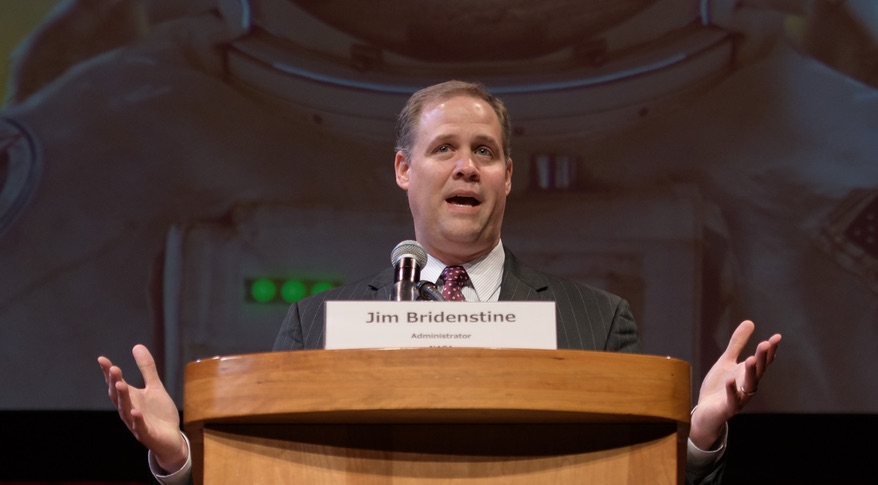Bridenstine Weighs In On National Space Policy

WASHINGTON — NASA Administrator Jim Bridenstine used a recent speech to lay out not just the recent space policy changes that directly affect NASA activities but other administration efforts that focus more on commercial space.
The comments by Bridenstine at a June 12 Space Transportation Association luncheon here reflect both the growing importance of commercial space to the agency's overall activities but also his interest in interest in broader space policy issues from his time as a member of Congress.
"I think a lot of people might believe that it's this massive transformational change," he said of the two space policy directives signed by President Trump to date. "In some ways it is, and in other ways it's not." [Presidential Visions for Space Exploration: From Ike to Trump]
The directive most relevant to NASA is Space Policy Directive (SPD) 1, signed by the president in December, which formally directs NASA to return humans to the moon as a step towards eventual missions to Mars. That has led NASA to develop an "Exploration Campaign" that includes steps from the development of the Lunar Orbital Platform-Gateway to plans to fly payloads on commercial lunar landers.
That directive, he said, was in fact just a small amendment to the national space policy signed by President Obama in 2010 and which remains in force today. The key element of that change, he said, is an emphasis on a "sustainable" human return to the moon.
"Our objective is to make sure that, over the long term, we're going to have a human presence at the moon," he said. "We want a sustainable, long-term presence at the moon."
The Gateway, he said, is essential to that. "A lot of folks may not understand how important the Gateway is to this architecture," he said. The Gateway, he argued, is a long-term outpost that supports both lunar exploration as well as future deep space missions. "The glory of the Gateway is that it's not just for the moon," he said. "In future years, it is the best point from which to go deeper."
Get the Space.com Newsletter
Breaking space news, the latest updates on rocket launches, skywatching events and more!
Bridenstine said that Space Policy Directive 2, signed May 24, is also critical to the agency. That policy addresses commercial space regulatory reforms, from streamlined launch licensing to the creation of a "one-stop shop" for most commercial space regulatory issues within the Commerce Department.
Launch licensing reform is important to NASA, he said, because of the growing role commercial launch providers play in enabling NASA's missions. "We're a utilizer of that service," he said. "We are very keen on making sure that regulatory environment is good because it decreases our costs and increases our access."
A related issue is oversight of so-called "non-traditional" commercial space activities not currently licensed or otherwise overseen by government agencies. "Who in the United States does authorization and continuing supervision for a commercial habitat in low Earth orbit? There isn't anybody who does that," he noted. The same is true, he noted, for commercial lunar missions, like those NASA wants to take advantage of.
SPD-2 doesn't directly address that but does set the stage for giving that authority to Commerce. The House passed in April the American Space Commerce Free Enterprise Act, which would also give that authority to the Commerce Department. However, a commercial space bill under development in the Senate, but not yet formally released, may seek to give that authority to the Transportation Department, according to industry sources.
Bridenstine declined to take a position on which agency should have that authority. "There might be some disagreement between the House and the Senate on that. I'm not going to weigh in on that, at least at this juncture," he said. "The important thing to recognize is that it needs to be done. That's the key."
He also touched upon the next space policy directive, which has yet to be released but is widely expected to be announced as soon as the next National Space Council meeting June 18. "It's pre-decisional," he said of that policy, but referred to a speech by Vice President Mike Pence at the 34th Space Symposium April 16 that announced a draft space traffic management policy.
"The orbital debris challenge is very real. It's getting more difficult every day," he said. The problem is complicated, he added, by plans for mega-constellations of hundreds or thousands of satellites by several companies. "If we don't start now putting together the right process to do space situational awareness and space traffic management, this is not going to go well."
He didn't discuss any details of what might be in SPD-3 but says that he believed the vice president and National Space Council are "very keen" to find the right solution, suggesting it might result in different regulations for different orbits based on the risks. "Everybody I've talked to on the National Space Council is interested in a minimal regulatory environment," he said. "But, at the same time, an environment that is safe."
This story was provided by SpaceNews, dedicated to covering all aspects of the space industry.
Join our Space Forums to keep talking space on the latest missions, night sky and more! And if you have a news tip, correction or comment, let us know at: community@space.com.

Jeff Foust is a Senior Staff Writer at SpaceNews, a space industry news magazine and website, where he writes about space policy, commercial spaceflight and other aerospace industry topics. Jeff has a Ph.D. in planetary sciences from the Massachusetts Institute of Technology and earned a bachelor's degree in geophysics and planetary science from the California Institute of Technology. You can see Jeff's latest projects by following him on Twitter.










